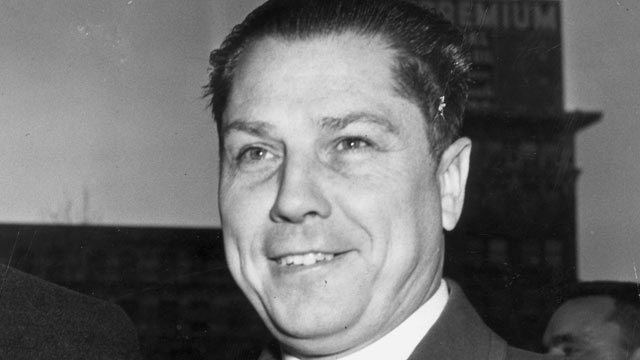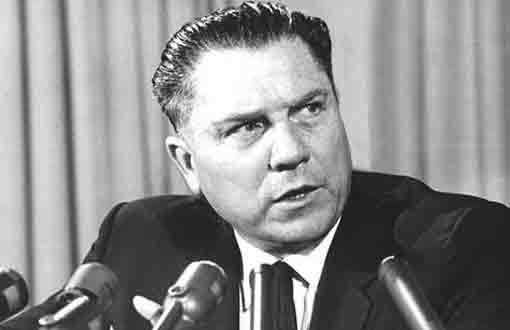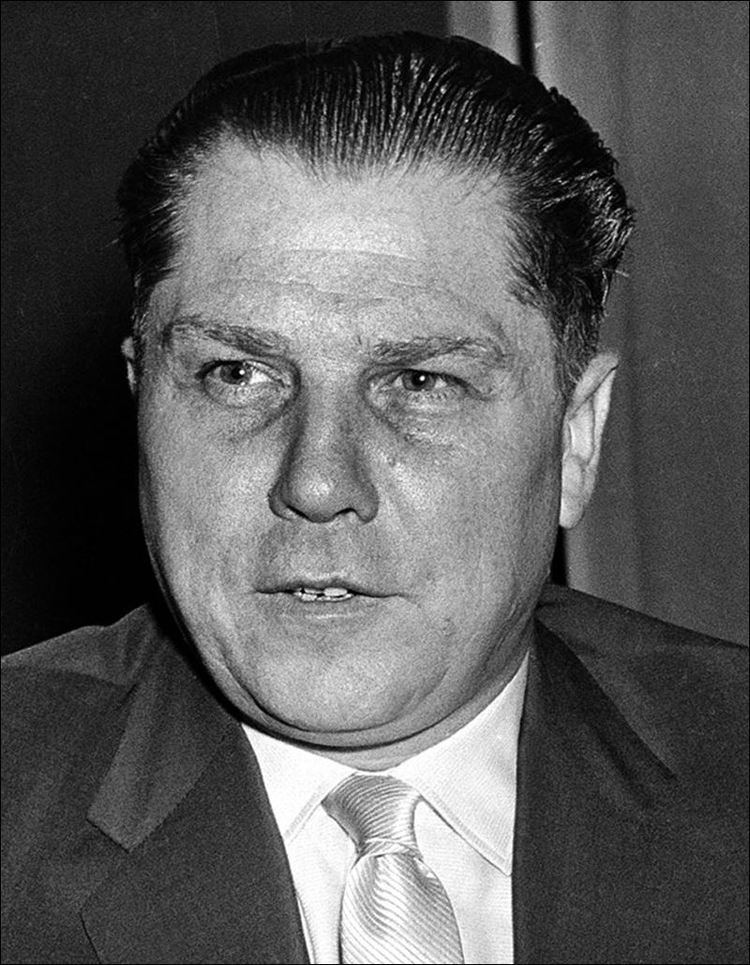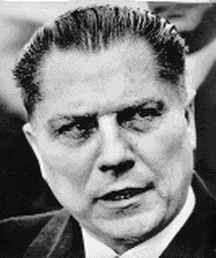Name Jimmy Hoffa Books Hoffa: The Real Story Nationality American | Died July 30, 1982 Role Author | |
 | ||
Full Name James Riddle Hoffa Status Declared dead in absentiaJuly 30, 1982(1982-07-30) Spouse Josephine Poszywak (m. 1936–1982) Children James P. Hoffa, Barbara Ann Crancer Similar People | ||
Moldea on the rise and fall of Jimmy Hoffa - Part 1
Where is Jimmy Hoffa? Former Driver's Theory
James Riddle Hoffa (February 14, 1913 – disappeared July 30, 1975) was an American labor union leader who served as the President of the International Brotherhood of Teamsters (IBT) union from 1958 until 1971. He vanished in late July 1975, at age 62.
Contents
- Moldea on the rise and fall of Jimmy Hoffa Part 1
- Where is Jimmy Hoffa Former Drivers Theory
- Early life and family
- Personal life
- Early union activity
- Growth of the Teamsters
- Hoffas rise to power
- Teamsters Union presidency
- Teamsters union expelled
- National Master Freight Agreement
- Criminal charges
- Prison sentences
- Appoints Fitzsimmons as caretaker president
- Post prison
- Disappearance
- Claims and developments
- Media portrayals
- References

Hoffa was a union activist from a young age and an important regional figure with the IBT by his mid-20s. By 1952 he had risen to national vice-president of the IBT, and served as the union's general president between 1958 and 1971. He secured the first national agreement for teamsters' rates in 1964. He played a major role in the growth and development of the union, which eventually became the largest (by membership) in the United States with over 1.5 million members at its peak, during his terms as its leader.

Hoffa became involved with organized crime from the early years of his Teamsters work, and this connection continued until his disappearance in 1975. He was convicted of jury tampering, attempted bribery, and fraud in 1964, in two separate trials. He was imprisoned in 1967 and sentenced to 13 years. In mid-1971, he resigned as president of the union as part of a pardon agreement with President Richard Nixon; he was released later that year, though barred from union activities until 1980. Hoffa, hoping to regain support and to return to IBT leadership, unsuccessfully attempted to overturn this order.

Hoffa vanished in late July 1975 and was declared legally dead in 1982. There are many theories as to what happened to him.

Early life and family
Hoffa was born in Brazil, Indiana on February 14, 1913, to Indiana natives John and Viola (née Riddle) Hoffa. His father, who was of Pennsylvania Dutch ancestry, died in 1920 when Hoffa was 7 years old. The family moved to Detroit in 1924, where Hoffa was raised and lived the rest of his life. Hoffa left school at age 14 and began working full-time manual labor jobs, to help support his family.
Personal life
Hoffa married Josephine Poszywak, an 18-year-old Detroit laundry worker of Polish heritage, at Bowling Green, Ohio on September 24, 1936; the couple had met during a non-unionized laundry workers' strike action six months earlier. The couple had two children: a daughter, Barbara Ann Crancer, and a son, James P. Hoffa. The Hoffas paid $6,800 in 1939 for a modest home in northwest Detroit. The family later owned a simple summer lakefront cottage in Orion Township, north of Detroit.
Barbara retired as an Associate Circuit Judge in St. Louis County, Missouri, in March 2008. One year later, she agreed to serve as an Associate Attorney General to the Attorney General for the State of Missouri, Chris Koster, as Chief Counsel of the Division of Civil Disability and Workers Rights. She retired from that post in March 2011. James has served as president of the Teamsters' Union since 1999.
Early union activity
Hoffa began union organizational work at the grassroots level through his employment as a teenager with a grocery chain, a job which paid substandard wages and offered poor working conditions with minimal job security. The workers were displeased with this situation and tried to organize a union to better their lot. Although Hoffa was young, his bravery and approachability in this role impressed fellow workers, and he rose to a leadership position. By 1932, after defiantly refusing to work for an abusive shift foreman, who inspired Hoffa's long career of organizing workers, he left the grocery chain, in part because of his union activities, and Hoffa was then invited to become an organizer with the Local 299 of the Teamsters in Detroit.
Growth of the Teamsters
The Teamsters union, founded in 1903, had 75,000 members in 1933. As a result of Hoffa's work with other union leaders to consolidate local union trucker groups into regional sections and then into one gigantic national body—work that Hoffa ultimately completed over a period of two decades—membership grew to 170,000 members by 1936. Three years later, there were 420,000; and the number grew steadily during World War II and through the post-war boom to top a million members by 1951.
The Teamsters organized truck drivers and warehousemen, first throughout the Midwest, and then nationwide. Hoffa played a major role in the union's skillful use of "quickie strikes", secondary boycotts, and other means of leveraging union strength at one company, to then move to organize workers, and finally to win contract demands at other companies. This process, which took several years starting in the early 1930s, eventually brought the Teamsters to a position of being one of the most powerful unions in the United States.
However, trucking unions in that era were heavily influenced by, and in many cases controlled by elements of, organized crime. For Hoffa to unify and expand trucking union groups, he had to make accommodations and arrangements with many gangsters, beginning in the Detroit area. Organized crime influence on the IBT would expand as the union itself grew.
Hoffa's rise to power
Hoffa worked to defend the Teamsters unions from raids by other unions, including the CIO, and extended the Teamsters' influence in the Midwestern states, from the late 1930s to the late 1940s. Although he never actually worked as a truck driver, he became president of Local 299 in December 1946. He then rose to lead the combined group of Detroit-area locals shortly afterwards, and advanced to become head of the Michigan Teamsters groups sometime later. During this time, Hoffa obtained a deferment from military service in World War II, by successfully making a case for his union leadership skills being of more value to the nation, by keeping freight running smoothly to assist the war effort.
At the 1952 IBT convention in Los Angeles, he was selected as national vice-president by incoming president Dave Beck, successor to Daniel J. Tobin, who had been president since 1907. Hoffa had quelled an internal revolt against Tobin by securing Central States regional support for Beck at the convention. In exchange, Beck made Hoffa a vice-president.
The IBT moved its headquarters from Indianapolis to Washington, D.C., taking over a large office building in the capital in 1955. IBT staff was also enlarged during this period, with many lawyers hired to assist with contract negotiations. Following his 1952 election as vice-president, Hoffa began spending more of his time away from Detroit, either in Washington or traveling around the country for his expanded responsibilities.
Teamsters Union presidency
Hoffa took over the presidency of the Teamsters in 1957, at the convention in Miami Beach, Florida. His predecessor, Dave Beck, had appeared before the John Little McClellan-led US Senate Select Committee on Improper Activities in Labor or Management Field in March 1957, and took the Fifth Amendment 140 times in response to questions. Beck was under indictment when the IBT convention took place, and was convicted on fraud charges later that year at a trial held in Seattle, and imprisoned.
Teamsters union expelled
The 1957 AFL–CIO convention, held in Atlantic City, New Jersey, voted by a ratio of nearly 5-1 to expel the IBT from the larger union group. President George Meany gave an emotional speech, advocating removal of the IBT, and stating that he could only agree to further affiliation of the Teamsters if they would dismiss Hoffa as their president. Meany demanded a response from Hoffa, who replied through the press, "We'll see." At the time, IBT was bringing in over $750,000 annually to the AFL-CIO.
National Master Freight Agreement
Following his re-election as president in 1961, Hoffa worked to expand the union. In 1964, he succeeded in bringing virtually all over-the-road truck drivers in North America under a single National Master Freight Agreement, in what may have been his finest achievement in a lifetime of union activity. He then tried to bring the airline workers and other transport employees into the union, with limited success. During this period, he was facing immense personal strain as he was under investigation, on trial, launching appeals of convictions, or imprisoned for virtually all of the 1960s.
Hoffa was re-elected, without opposition, to a third five-year term as president of the Teamsters Union, despite having been convicted of jury tampering and mail fraud in court verdicts that were stayed pending review on appeal. Delegates in Miami Beach also elected Frank Fitzsimmons as first vice-president, to become President "if Hoffa has to serve a jail term".
Criminal charges
Hoffa had first faced major criminal investigations in 1957, as a result of the John Little McClellan Senate Labor Subcommittee's work. He avoided conviction for several years, but when John F. Kennedy was elected president in 1960, he appointed his younger brother Robert F. Kennedy as Attorney General. Robert Kennedy had been frustrated in earlier attempts to convict Hoffa, while working as counsel to the McClellan Subcommittee. As Attorney General from 1961, Robert Kennedy pursued the strongest attack on organized crime that the country had ever seen, and he carried on with a so-called 'Get Hoffa' squad of prosecutors and investigators.
Prison sentences
In 1964, Hoffa was convicted in Chattanooga, Tennessee, of attempted bribery of a grand juror, and was sentenced to eight years. This case resulted from an earlier matter, the Test Fleet case, the trial for which had been held in Nashville, Tennessee. Hoffa was implicated by one of his close associates, Edward Grady Partin, a Louisiana teamster, who went to the Federal Bureau of Investigation (FBI) with the information that led to Hoffa's conviction. Hoffa was also convicted of fraud later that same year for improper use of the Teamsters' pension fund, in a trial held in Chicago. Hoffa had illegally arranged several large pension fund loans to leading organized crime figures. He received a five-year sentence to run consecutively to his bribery sentence. Robert F. Kennedy, who had pursued Hoffa for several years, since the McClellan-led U.S. Senate Labor industry hearings of 1957, stepped down as Attorney General in 1964, after the second Hoffa conviction, to run successfully for the New York seat in the November 1964 United States Senate election.
Hoffa spent the next three years unsuccessfully appealing his 1964 convictions. Appeals filed by his chief counsel, St. Louis defense attorney Morris Shenker, reached the U.S. Supreme Court. He began serving his sentences in March 1967 at the Lewisburg Federal Penitentiary in Pennsylvania.
Appoints Fitzsimmons as caretaker president
Just before he entered prison, Hoffa appointed Frank Fitzsimmons as acting Teamsters president. Fitzsimmons was a Hoffa loyalist, fellow Detroit resident, and a longtime member (since the 1930s) of Teamsters Local 299 in Detroit, who owed his own high position in large part to Hoffa's influence. Despite this, Fitzsimmons soon distanced himself from Hoffa's influence and control after 1967, to Hoffa's displeasure. Fitzsimmons also decentralized power somewhat within the Teamsters' union administration structure. During the Hoffa era, Hoffa had kept most power in his own hands.
Post-prison
On December 23, 1971, less than five years into his 13-year sentence, Hoffa was released from prison when President Richard Nixon commuted his sentence to time served. Following his release, Hoffa was awarded a Teamsters' pension of $1.7 million, delivered in a one-time lump sum payment. This type of pension settlement had not occurred before with the Teamsters.
The IBT endorsed Richard Nixon, the Republican Party's candidate, in his presidential reelection bid in 1972; in prior elections, the IBT union had supported Democratic Party nominees but had also endorsed Nixon in 1960. Suspicion was soon raised of a deal for Hoffa's release connected with the IBT's support of Nixon in 1972. It was alleged that a large sum of money, estimated to be as high as $1 million, was paid secretly to Nixon. Evidence was also alleged of a secret bribe paid in 1960.
While glad to regain his freedom, Hoffa was very disappointed with the condition imposed on his release by President Nixon, which prevented Hoffa from engaging in union activities until March 1980. He accused senior Nixon administration figures, including Attorney General John N. Mitchell and White House Special Counsel Charles Colson, of depriving him of his rights by initiating this clause; Mitchell and Colson both denied this. It was likely imposed upon Hoffa as the result of requests from the Teamsters' leadership, although IBT President Frank Fitzsimmons also denied this.
Hoffa sued to invalidate the non-participation restriction in order to reassert his power over the Teamsters, and John Dean, former White House counsel to President Nixon, was among those called upon for depositions in 1974 court proceedings. Dean, who had become famous as a government witness in prosecutions arising from the Watergate scandal by mid-1973, had drafted the non-participation clause in 1971 at Nixon's request. Hoffa ultimately lost his court battle, since the court ruled that Nixon had acted within his powers by imposing the restriction, as it was based on Hoffa's misconduct while serving as a Teamsters' official.
Hoffa faced immense resistance to his reestablishment of power from many corners and had lost much of his earlier support, even in the Detroit area. As a result, he intended to begin his comeback at the local level with Local 299 in Detroit, where he retained some influence.
In 1975, Hoffa was working on an autobiography titled Hoffa: The Real Story, which was published a few months after his disappearance. He had earlier published a book titled The Trials of Jimmy Hoffa (1970).
Disappearance
Hoffa disappeared sometime after 2:45 p.m. on July 30, 1975, from the parking lot of a restaurant in Bloomfield Township, a suburb of Detroit. He had told others he was going there to meet with two Mafia leaders: Anthony Giacalone and Anthony Provenzano. Provenzano was also a Teamster leader in New Jersey and had earlier been close to Hoffa. Provenzano was a national vice-president with IBT from 1961, Hoffa's second term as Teamsters' president.
Hoffa arrived at around 2:00, and after waiting nearly 30 minutes he called his wife and told her he would wait a few more minutes. A truck driver claimed to have recognized Hoffa in the back seat of a car that almost hit his truck as it left the restaurant parking lot; he also saw a long object covered with a gray blanket on the seat between Hoffa and another passenger.
Hoffa's wife reported him missing that evening. Police found his car at the restaurant, unlocked, but there was no indication of what happened to him. Years of extensive investigation, involving numerous law enforcement agencies including the FBI, came to no definite conclusion. Giacalone and Provenzano, who denied having scheduled a meeting with Hoffa, were found not to have been near the restaurant that afternoon.
Hoffa was declared legally dead on July 30, 1982. The case continues to be the subject of rumor and speculation.
Claims and developments
In 1989, Kenneth Walton, the head of the FBI's Detroit office, told The Detroit News he knew what happened to Hoffa. “I’m comfortable I know who did it, but it’s never going to be prosecuted because… we would have to divulge informants, confidential sources.”
In 2001, the FBI matched DNA from Hoffa's hair—taken from a brush—with a strand of hair found in a 1975 Mercury Marquis Brougham driven by longtime friend Charles "Chuckie" O'Brien on July 30, 1975. Police and Hoffa's family had long believed O'Brien played a role in Hoffa's disappearance. O'Brien, however, had previously denied ever being involved in Hoffa's disappearance or that Hoffa had ever been a passenger in his car.
In a season 1 episode of the Discovery Channel show MythBusters, titled "The Hunt for Hoffa", the locations in Giants Stadium where Hoffa was rumored to be buried were scanned with a ground penetrating radar to see if any disturbances were present that would indicate a human body had been buried there. They found no trace of any human remains. No human remains were found when Giants Stadium was demolished in 2010.
In the book, I Heard You Paint Houses: Frank "The Irishman" Sheeran and the Closing of the Case on Jimmy Hoffa (2004), author Charles Brandt claims that Sheeran, a professional killer for the mob and longtime friend of Hoffa's, confessed to assassinating Hoffa. According to Brandt, Chuckie O'Brien drove Sheeran, Hoffa, and fellow mobster Sal Briguglio to a house in Detroit. He claimed that while O'Brien and Briguglio drove off, Sheeran and Hoffa went into the house, where Sheeran claims that he shot Hoffa twice behind the right ear. Sheeran says that he was told that Hoffa was cremated after the murder. Sheeran also confessed to reporters that he murdered Hoffa. Blood found in the Detroit house where Sheeran claimed the murder happened was determined not to be Hoffa's.
On June 16, 2006, the Detroit Free Press published in its entirety the so-called "Hoffex Memo", a 56-page report the FBI prepared for a January 1976 briefing on the case at FBI Headquarters in Washington, D.C. Although not claiming to conclusively establish the specifics of his disappearance, the memo indicates that law enforcement's belief is that Hoffa was murdered at the behest of organized crime figures who deemed his efforts to regain power within the Teamsters was a threat to their control of the union's pension fund. The FBI has called the report the definitive account of what agents believe happened to Hoffa.
In 2012, Roseville, Michigan police took samples from the ground under a suburban Detroit driveway after a person reported witnessing the burial of a body around the time of Hoffa's 1975 disappearance. Tests by Michigan State University anthropologists found no signs of human remains.
In January 2013, reputed gangster Tony Zerilli implied that Hoffa was originally buried in a shallow grave, with the plan that his remains would later be moved to a second location. Zerilli contends that these plans were abandoned, and Hoffa's remains lay in a field in northern Oakland County, Michigan, not far from the restaurant where he was last seen. Zerilli denied any responsibility for or association with Hoffa's disappearance. On June 17, 2013, the Zerilli information led to a property in Oakland Township in northern Oakland county owned by Detroit mob boss Jack Tocco. After three days, the FBI called off the dig. No human remains were found, and the case remains open.
Media portrayals
Hoffa is portrayed by:
